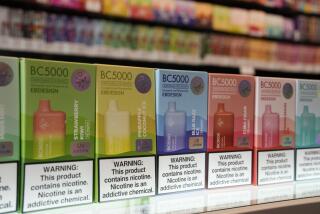Study: Hookah use up among teens, especially white males with money
Nearly 1 in 5 American high school seniors has used a hookah at least once in the preceding year, and the risk was greater for students from higher-income families, according to a study published Monday in the journal Pediatrics.
Hookahs, a type of water pipe, have become increasingly popular in recent years in the U.S. and abroad, numerous studies have reported. Experts believe this is due in part to the perception that they are less dangerous than cigarettes and other forms of smoking.
The authors of the new report describe hookahs as “an ancient form of smoking in which shisha (an herbal material that can be tobacco- or non-tobacco-based) smoke is passed through water before inhalation.” The water pipes originated in ancient Persia and India; in today’s urban cities, they are frequently shared in hookah bars or hookah lounges, where smoking is seen as a social activity.
Data from 5,440 students who took the annual Monitoring the Future survey show that 18% of 12th-graders had tried a hookah in the 12 months before answering the questionnaire, the researchers said. That figure is the average of survey responses for the years 2010, 2011 and 2012.
The study authors, from New York University’s Langone Medical Center, found that the typical student who had used a hookah was a white male with well-educated parents and a steady source of spending money. “Given the cost of frequenting hookah bars, it is not surprising that wealthier students, as indicated by higher weekly income, are more regular visitors,” the researchers wrote.
Their statistical analysis showed that:
* Compared with boys, girls were 19% less likely to have used a hookah in the year before they took the survey.
* Compared with whites, students who identified themselves as black were 73% less likely to have used a hookah.
* Compared with students in rural areas, those who lived in urban areas (defined as counties where at least one city had at least 50,000 residents) were more than 2.6 times more likely to report hookah use.
* Compared with students whose parents were not well educated, students from homes with highly educated parents were 58% more likely to have used a hookah.
* Compared with students with limited income, those who earned at least $50 per week from a job were 26% more likely to have used a hookah. In addition, those who received between $11 and $50 per week from “other sources” were 35% more likely to have smoked.
Most states allow adults to use hookahs once they turn 18, and some high school seniors certainly meet this requirement. But in some ways, the popularity of hookahs seemed to mirror the use of illegal substances. For instance, students who said they had used alcohol were 3.3 times more likely than abstainers to have tried a hookah; students who had ever tried marijuana were 4.5 times more likely to have tried a hookah; and students who had used cocaine, LSD and other narcotics were 53% more likely to have tried a hookah.
By far, the biggest risk factor associated with hookah use was smoking: High school seniors who regularly smoked cigarettes were more than 5 times more likely than nonsmokers to have used a hookah, the researchers found. Even students who said they had smoked only once or twice in their lives were more than twice as likely as nonsmokers to say they had used a hookah.
Although some of the risk factors for hookah use – high parental education and high family income – are linked to lower rates of teen smoking, the study authors expressed concern that hookahs may serve as a “gateway to cigarette smoking” for some high school students.
The researchers also said they believed that the misconception that hookahs are less dangerous than cigarettes “probably leads to the social normalization of hookah use as a trendy and acceptable way to have fun with friends.” In reality, the water pipes expose smokers to “tar, nicotine and carbon monoxide in even higher doses than cigarettes,” the study said.
Medical researchers have found links between hookah use and lung cancer, esophageal cancer, respiratory and cardiovascular problems, dental problems, fertility issues and infectious diseases. One bright spot is that several studies have found that when people understand the true risks of hookahs, they are less likely to use them.
Follow me on Twitter @LATkarenkaplan for the latest news on health and medical research.


![Los Angeles, CA - May 19: Oscar Magana, 22, left, who struggles with mental problems but does not use drugs, sits in his tent as his step father, Johnny Roman, right, 58, who is addicted to meth, bipolar, manic depressive, and ADHD, puts bags of supplies for drug use in their tent encampment near Avalon Boulevard and East Florence Avenue in South Los Angeles Friday, May 19, 2023. The bags of supplies were distributed by a team from Homeless Outreach Program Integrated Care Systems [HOPICS] and includes drug pipes, overdose reversal nasal spray, fentanyl test strips, wipes and educational materials are aimed at preventing infection and disease, and saving them from the fentanyl death crisis. (Allen J. Schaben / Los Angeles Times)](https://ca-times.brightspotcdn.com/dims4/default/ab5c2ec/2147483647/strip/true/crop/3900x2608+0+163/resize/320x214!/quality/75/?url=https%3A%2F%2Fcalifornia-times-brightspot.s3.amazonaws.com%2Ff2%2Fc8%2Fa65d8e8f48afab4d760e8df4219e%2F1298639-me-soaring-fentanyl-deaths-16-ajs.jpg)




